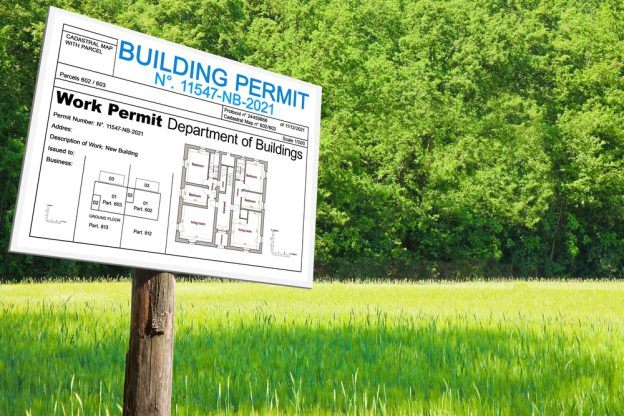Introduction
“Does a contractor have to pull permits?” is a question that every contractor runs into at some point early on in their careers. Given the legal ramifications of running afoul of local codes and regulations, it’s no wonder this is a question that gives many a new contractor cause for pause.
So – are contractors the ones who are responsible for pulling permits for the job? Or is it the construction manager, project manager, or maybe even the foreman on the job site? Does the responsibility change depending on whether you’re a general contractor or a Class C specialty contractor?
In this article, we’ll cover everything about permits: what they are, who is responsible for acquiring the right permit, the legal points surrounding permits, and so on. Let’s dig in.
What Does “Pulling Permits” Mean?
Pulling permits is a colloquial term used to describe the act of securing the necessary permits or authorizations from relevant governmental bodies. Usually, permits are given out by local governments like counties, cities, or townships.
These permits ensure that the construction or renovation work complies with local building codes, zoning laws, and other regulations. Actually “pulling” a permit requires a number of steps – involves submitting detailed plans of the proposed project for approval, and working with local government to make any changes until your plans meet the necessary code. After your project is approved, you’ll receive your permit – but whether or not you’re in violation of said permit may require inspections before, during, or after the construction.
The Legal Landscape
No matter where you do construction work, there’s a well-defined legal framework that mandates contractors to secure permits for particular types of work.
For example, the California Code of Regulations requires employers to obtain Project Permits and Annual Permits from Cal/OSHA before initiating specific construction activities. These regulations aim to ensure that all construction activities meet the safety and quality standards set by the state.
Who is Responsible for Pulling Permits?
As always with construction, the responsibility for pulling permits…depends on so many factors.
This burden generally falls on the contractor overseeing the project, but that could be anyone from a general contractor to a homeowner installing a new window. In a typical construction company, however, the task of applying for, compiling, and maintaining permits is often assigned to a project manager, or in some cases, a designated permit expediter.
They are responsible for understanding the types of permits required, gathering the necessary documentation, and liaising with the relevant authorities.
However, in some cases, either the homeowner or a licensed contractor can secure the essential permits. This would be in situations where it’s you doing work on your own home, or where you’re an out-of-town GC who hires a local. In many cases, the local will know the permitting system in their local jurisdiction better than you would, so in that case, they may offer to take care of that (often for an additional fee).
How to Obtain a Permit
Obtaining a permit usually involves several steps, but they’re rather straightforward and follow simple common sense.
- Identify The Type of Permit Needed: Different projects may require different types of permits, such as building, electrical, or plumbing permits.
- Develop Plans: Create detailed plans for the project that comply with all local bylaws and regulations.
- Submit Plans: Now take your plans and submit them to the relevant authority for review and approval.
- Pay Fees: There are usually fees associated with permit applications. Most of the time they are paid upon submission, but you may also be waived the fee in the case of a permit rejection.
- Await Approval: Once submitted, the application undergoes a review process, which may take anywhere from a few days to several weeks. Not much you can do in this step of the process but prepare your resources for deployment when you do get approved.
- Receive Your Permit: If your permit is found to be compliant with the authority’s regulations, you will receive your permit! If not, you will usually get a chance to re-apply for a new permit.
What Requires a Building Permit in California?
While California is stringent about environmental regulations, each municipality interprets these regulations uniquely for their specific area.
Generally, projects that likely require a building permit in California include:
- Demolition of an existing building
- Roof replacement
- Plumbing, electrical, and mechanical replacements
- Adding an accessory dwelling unit (ADU) or a junior accessory dwelling unit (JADU)
- Changing the layout of a house
- The addition or removal of exterior walls
- Stormwater
- Grading
- Mechanical Operation
It’s crucial to note that additional permits, such as stormwater, electrical, plumbing, grading, and mechanical permits, might be required based on the project’s scope.
Examples of Permits You Need For Construction In California
With one of the most complicated and comprehensive legal frameworks in the nation, California mandates contractors to obtain permits for almost any type of construction work.
The California Code of Regulations, for instance, requires employers to secure Project Permits and Annual Permits from Cal/OSHA for specific construction activities1.
You may also have to deal with permitting for the California Environmental Quality Act (CEQA). This usually involves an environmental review for projects that may have significant environmental impacts, ensuring sustainable development for projects that can affect the local ecology. These days, that’s most projects.
Here are some more types of permits you might run into in California, depending on your location, the nature of the job, and what role you have.
- Annual Construction Permits: These permits are required for specific construction activities and are issued by the Division of Occupational Safety and Health (DOSH). More information on annual construction permits and the list of permit holders can be found on the DOSH Annual Construction Permit Holders page.
- Construction Stormwater Permit: Construction projects in certain watersheds must apply for a Regional Water Board permit rather than a statewide permit. More details are available on the Construction Stormwater Program page.
- Building Permits: These are required for various construction activities such as building garages, storage buildings, decks, carports, patio covers, and additions to single-family dwellings. More information can be found on the Building Department Documents page.
- Energy Compliance Permits: Compliance with Title 24, State Energy Code, is mandatory for construction projects in California. More details are available on the Building Permit – Department of Planning and Development page.
- Model Code Adherence Permits: Every three years, the State of California adopts new and/or updated model codes and adherence to these codes is mandatory. More information is available on the Building Permits and Inspection – Sacramento County page.
Do You Need To Pull A Permit As A Contractor?
Let’s answer the question once and for all: do you need to pull permits as a contractor in California?
And everyone’s favorite answer: most likely, but it depends!
California is a complex patchwork of legal standards, especially when it comes to construction. In addition to statewide regulations like sustainability standards, you have local codes and bylaws that are county, city, town, or even community-wide.
With that in mind, the reality is that you will most likely have to pull a permit as a contractor, at some point! The most important thing is you familiarize yourself with all the codes and regulations in the area you’ll be operating in.
It’s your responsibility to know the codes and adhere to them – or face the consequences, which can often be severe. Even if you’re not physically the one pulling the permits, you could face such penalties as a suspended or revoked CSLB license!
Additional Reading
California Department of Industrial Relations – Permit Requirements
Census.gov – Building Permit Survey
AvaTrade – What Are Building Permits?









